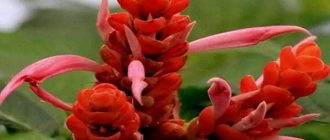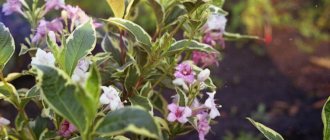The genus Privet (Ligustrum) includes several dozen species, mainly shrubs, growing in Asia, Africa and Europe.
Most types of culture can be found in the Himalayas, Japan and China. The bark of the culture has an astringent medicinal property, hence the name of the genus - “ligare”, from the Latin verb “to bind”. Interestingly, in English-speaking countries the plant is known as Privet.
Good shade tolerance, low requirements for soil quality, tolerance to topiary and ease of care have made the ornamental privet shrub one of the most versatile plants in landscape design.
Description of privet
The plant is a densely foliated, branched and very hardy shrub, which is one of the most popular in horticulture for creating hedges.
The leaves are small, leathery, evergreen or deciduous. The height, depending on the type, is approximately 1.5-3 meters, but growth is perfectly controlled by pruning, which helps to form a wide variety of planting shapes. The height of dwarf varieties is only 60 -100 cm.
The flowers are white and fragrant, collected in loose paniculate inflorescences at the tops of the shoots, reminiscent of lilac flowers. Flowering is long lasting, usually beginning in early June. In warm climates it may start earlier. After flowering, shiny black berries ripen and usually remain on the bushes all winter.
The berries are poisonous to both dogs and humans, and the leaves can be even more toxic in large quantities. Their toxicity is due to the presence of terpenoid glycosides, which cause poisoning of the body.
Privet berries
After flowering, fruits form in early autumn. They have a dark burgundy or blue-black hue. They perfectly decorate the branches of the plant. The fruits have 1-4 seeds. They are a berry-like drupe.
In common parlance, this representative of the flora is called “wolf berry.” But eating berries is strictly prohibited. They are poisonous. Cause severe poisoning of the entire body. First, a person begins to feel dizzy and his mouth becomes dry. Loss of consciousness occurs.
If you do not intervene and take measures to eliminate the berries from the stomach, the poison can penetrate the blood. After this, severe intoxication occurs, which can be fatal.
Important! Privet berries are poisonous not only to humans, but also to animals.
Types of ornamental privet shrubs
Common privet (Ligustrum vulgare) . The hardiest deciduous species, which can most often be found in the garden as a hedge. It is characterized by good winter hardiness and shade tolerance.
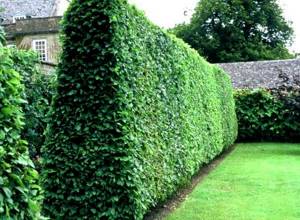
Through the efforts of breeders, decorative varieties have been developed that are distinguished by their crown shape: pyramidal shape, weeping, evergreen, as well as foliage color: privet aurea, glaucous, variegated group with variegated foliage and yellow-fruited.
Shiny privet (Ligustrum lucidum) . This is a fairly small evergreen tree or shrub with glossy, ovate, variegated leaves, green with beige-yellow spots or edges. The flowers are small, creamy, fragrant, collected in inflorescences up to 20 cm in length. Blooms from July to early autumn. Withstands frosts down to minus 15 °C.
Excelsum Superbum is a low evergreen or semi-evergreen tree with small, glossy green leaves edged with bright yellow.
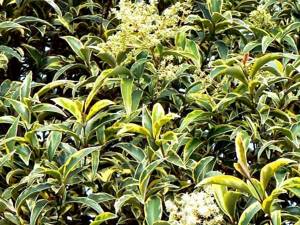
Variety “Curly Wurly” - leaves of an unusual shape, as if twisted, colored beige-green.
Japanese privet (Ligustrum japonicum) . In appearance it is very similar to Ligustrum lucidum, but is more winter-hardy in cultivation. The leaves are small, evergreen, leathery, glossy.
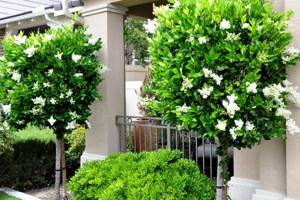
The flowers have an unpleasant smell, but this is fully compensated by the high decorativeness of the species, which includes a group of round-leaved privet and a group with variegated foliage. For example, “Sunshine” is a sterile variety with golden foliage or “Jack Frost” has golden-green leaves.
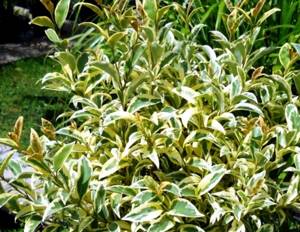
Chinese privet (Ligustrum sinense) . Semi-evergreen large shrub reaching 3 meters in height. It has small yellow-green variegated leaves. Adapts to various soil types. Dwarf variegated varieties are popular in gardening, such as 'Swift Creek', a small spreading shrub with creamy green leaves.
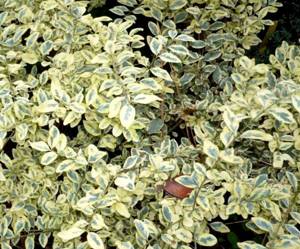
"Swift Creek"
Oval-leaved privet (Ligustrum ovalifolium). A low and dense shrub with variegated, evergreen foliage. For the winter it needs shelter due to its sensitivity to frost.
Depending on the color it is divided into groups:
- variegated green-leaved group with a light, often white border along the edges of the leaf blade;
- silver group Argentum, the foliage of which is also bordered by a beige or light yellow stripe;
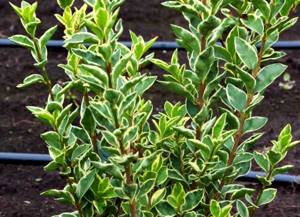
- Aureum group or golden privet is one of the most popular in landscape design. It is a dense, compact bush about a meter tall with oval, lemon-yellow or lime-yellow leaves. A stunning dwarf 'Lemon & Lime' variety with golden leaves that contrast with the deep red or purple berries.
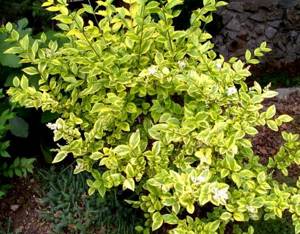
General description of the bush
The shrub-like plant is up to one meter wide and can grow up to two meters in length. The trees reach a height of six meters. On the branches of the plant, leathery, elongated-ovate, entire leaves are located oppositely. They are dark green above and lighter below. White fragrant flowers are collected in paniculate loose inflorescences, which bloom in June or July and bloom for about three months. After flowering, round, small, berry-like fruits are formed - black or dark blue drupes. Each fruit contains from one to four seeds.
In the gardens of central Russia, common privet is most often grown, which is characterized by frost resistance and rapid growth.
How to plant privet
Almost any place in the garden for planting privet is suitable, but in order for the shrub to reach the peak of its attractiveness, it is better to plant it in an open sunny place, especially variegated varieties and species. The crop grows well on many types of substrate with good water permeability, but you should not expect plantings to flourish on highly acidic, heavy clay and sandy soils.
The best soil composition for growing is considered to be a mixture of three parts turf garden soil, two parts humus and one part coarse sand for water permeability.
Planting of single shrubs is carried out in spring or autumn in September-October, and privet for hedges is recommended to be planted from late March to summer. Although bushes with a closed root system can be planted all season.
Fertilizer is applied immediately when planting privet in the ground. 130 g of nitroammophoska is good for feeding, or mix the soil from the planting hole with humus, compost or a small part of rotted manure.
The planting hole should be 30 cm larger than the root ball. Water is poured into it, and when it is absorbed, the roots of the plant are placed in the hole and covered with soil. At first, regular watering is necessary. Experts recommend mulching the soil around the plantings with compost or peat. Mulch will provide additional feeding throughout the season, maintain adequate soil moisture and control weed growth.
You can learn more about the types of mulch and the benefits of mulching in this article.
Bushes intended for creating a privet hedge are planted in one or two rows. The width of the dug trench is 60 cm, and its depth is 80 cm. If we want to have a single-row hedge, then we plant bushes in a straight line with a distance of 50-60 cm between bushes in partial shade. In a sunny place, keep a distance of 80 cm.

In the case of a two-row privet hedge, dig two trenches located at a distance of about half a meter from each other. Planting of seedlings is carried out in a checkerboard pattern.
Plant species
The Privet genus includes more than 50 different subspecies .
They are united by the ability to adapt to any content or weather conditions. This representative of the flora is intended for inexperienced beginner gardeners.
The most common subspecies is the Common Privet. The plant was developed in the 19th century. The main difference from other types is increased frost resistance .
Thanks to this, this representative of the flora can be planted in open ground in the Russian Federation, Moldova, Ukraine, and Belarus.
The following subspecies can also adapt to the Russian climate:
- Privet Light;
- Japanese;
- Acute;
- Amurskaya;
- Ibota;
- Oval-leaved;
- Quihoe;
- Chinese;
- Chonoski;
- Iezskaya.
Important! The seeds of this representative of the flora are carried by thrushes.
More information about the types of privet can be found here.
Rules for caring for privet
Caring for privet throughout the season consists of timely irrigation of the soil, annual pruning and removal of weeds. The plant can withstand long droughts, so watering is carried out only in dry summers as needed.
The optimal watering regime is 3-4 times per season, but generously, so that the ground is saturated with moisture to a depth of 40-50 cm, this is about 2-3 buckets per medium-height bush. For small plantings up to a meter, it is enough to water 10 liters at a time. Young shrubs require more frequent watering during drought, since their roots are not yet extensive enough.
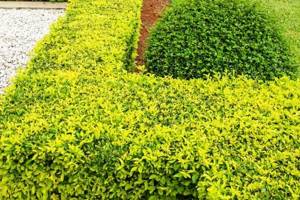
Despite the shade tolerance, the shrub prefers sunny positions or light partial shade. With a lack of lighting, the density of the foliage decreases, and in variegated varieties the brightness of the color fades.
In July, the soil around the plantings is carefully loosened after watering to increase oxygen access to the roots. After loosening, add a layer of mulch again.
Fertilizing is carried out in the spring with organic fertilizers: compost or humus. Hedges are more demanding when it comes to feeding, so once in the spring and once in the summer, organic matter and granules of mineral multicomponent fertilizers are poured along the plantings at the rate of 10 g per 1 meter. After which the plants are watered.
Privet: features of planting and care
Although privet is a rather unpretentious plant, it is recommended to follow a number of rules when planting it. This will allow the shrub to develop better, and therefore look better, which is important for an ornamental plant.
Five basic rules for growing privet:
- If in the southern regions this shrub is shade-tolerant, then in the middle zone it is necessary to plant it where it will receive enough light. There is no place for it under trees or on the northern sides of buildings.
- Privet roots grow in the ground mainly in a horizontal direction. Therefore, the top layer of soil must be well dug up and fertilized. This is not difficult to do. The most preferred soil for the plant: a mixture of turf, humus and sand (3:2:1, respectively), fertilized with mineral complexes and organic matter.
- Regular care consists of watering, loosening the soil and, of course, pruning; as well as applying fertilizers at the beginning of the gardening season - mineral, organic.
- Forming a hedge or shaping privet should begin as early as possible. To do this, pruning is done. In order for the plant to bush better, you need to pinch the shoots of young plants every 15 cm.
- If the plant does not tolerate frost well, then it must be additionally insulated for the winter.

One of the objects of landscape design in this country is karikomi - shrubs grown in the form of a dense pad
Privet pruning
As mentioned above, caring for the ornamental privet shrub includes sanitary pruning and, if desired, shaping pruning.
The annual procedure stimulates tillering and promotes the formation of a compact bush with dense foliage. You can experiment with the culture in creating topiary figures, since due to the intensive growth of the plant you can quickly hide a bad haircut. The plant is ideal for creating a regular garden.
To create a dense and dense crown of plantings or hedges, the shoots of privet seedlings are cut by 2/3 after planting. In summer, new young shoots are shortened by 10-20 cm. And so on for 2-3 years. During this time, the shrub intensively develops numerous side shoots. The larger the green mass, the easier it will be to subsequently make the necessary haircut or create a topiary figure.
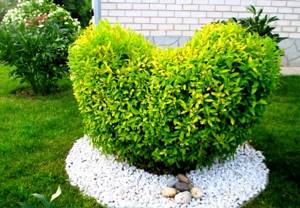
Old bushes can be rejuvenated by cutting off all shoots to a height of 10-20 cm. A year before the planned rejuvenation, the plant requires regular watering and fertilizing so that the bush gains strength before radical pruning. Sanitary pruning of all plantings is carried out annually in the spring. Remove dry, old, broken branches.
Privet propagation
Methods of propagation of the ornamental privet shrub include: seed method, cuttings, young layering or root shoots.
Propagation of privet by seeds
Due to the low germination of seeds, this method is considered quite difficult, especially since the crop begins to bear fruit for the first time only at the 6th year of life. To germinate, seeds need to undergo cold stratification, so they are sown in open ground before winter. For spring sowing, the seeds must be kept all winter in a box with a sand-peat mixture at a temperature of 0-1 °C. The refrigerator is best for storage.
The seed method is usually used in nurseries, and in private gardening the simplest and most effective method of obtaining new seedlings is vegetative.
Propagation of privet by cuttings
Woody cuttings 15-25 cm long are cut in the summer after the bush has flowered. The lower leaves are torn off, and the sections are dipped in powder, which stimulates root formation. They are buried 5-7 cm in a mixture of peat and perlite.

After planting, water well with a watering can and place the pot in a transparent bag or cover with a plastic bottle. Location – partial shade. Under conditions of constant substrate and air humidity, the rooting process takes 14-20 days.
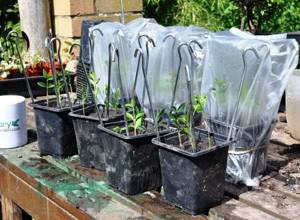
When signs of growth appear, the cover is removed and the cuttings are moved to a lighted place. The further process of development of the root system takes about a year. Therefore, cuttings are brought into the house in the fall and grown indoors, transplanting them into a larger pot in fertile soil as they grow.
It should be noted that seedlings need to be provided with cool conditions in winter, and fertilizing should begin in spring. By next summer we will receive full-fledged planting material.
Reproduction by layering and shoots
In the spring, a side shoot closer to the base is cut, cut down and secured in a pre-dug groove 1-2 cm deep. At the cut site, the layer is sprinkled with compost and sphagnum moss is laid out, which should always be moist. When signs of rooting appear (new leaves appear on the shoot), the cuttings are separated from the mother plant. Some species form root shoots around the bush, which can be dug up with part of the root.
Growing Ligustrum
The plant is actively used by landscape designers because of its decorative effect. Ligustrum is relatively unpretentious, but still requires some care. The plant is propagated by both seeds and vegetative methods.
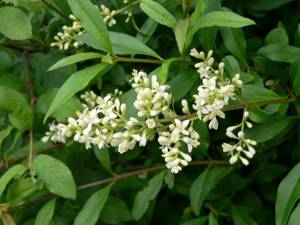
Propagation by seeds
For large-scale propagation, the method of propagation by seeds is used. However, if you only need to grow a few plants, this method is also quite suitable.
Seeds are taken from ripened fruits. For good results, it is better to use only the largest seeds. Before planting, the selected seeds should be thrown into a bowl of water. Those that float up are not suitable for landing.
Sowing is done in late autumn - early winter. Before planting, the ground must be leveled and small furrows made. Seeds are planted 7-10 centimeters from each other. The depth of embedding is 1-2 centimeters. The furrows are leveled with a rake and the soil is mulched. Seedlings can be transplanted to a new location after 2-3 years. It is advisable to cover young privet for the winter.
Privet can also be grown from seeds at home. Before planting, seeds must be stratified - that is, placed in the refrigerator for a couple of months. Plant the seeds in a loose substrate, one seed for each glass, to a depth of no more than 2 centimeters. The temperature in the room with seedlings should not be higher than 20 degrees. Watering is required, but moderate. For faster growth, you can backlight it. After a year or two, the seedlings can be transplanted to a permanent location.
Propagation by cuttings and layering
Cuttings are carried out after flowering has ended. Choose a healthy, well-developed shoot. The stalk should be about 10 centimeters long. A glass (pot) is filled with turf soil and the cutting is planted in it to a depth of about 5 centimeters. The pot is covered with a jar. The temperature should be 20−25 degrees. Moderate watering is required. Sometimes you need to ventilate the pot. You can transplant it to a permanent place when the plant reaches a height of half a meter.
Sometimes privet is propagated by layering. To do this, the shoot is bent to the ground, an incision is made and sprinkled with earth. The top is covered with moss. After a year, the leash is separated from the mother plant and replanted.
Landing in the ground
To thrive, privet requires nutritious, moist, slightly alkaline soil. Optimal soil composition:
- 50% turf land;
- 30% humus;
- 20% sand.
A hole is dug with a diameter of about 60 centimeters. Depth - a spade bayonet more than the root system of the plant. After planting, the hole is well filled with water. For hedges, holes are made at a distance of half a meter from one another.






